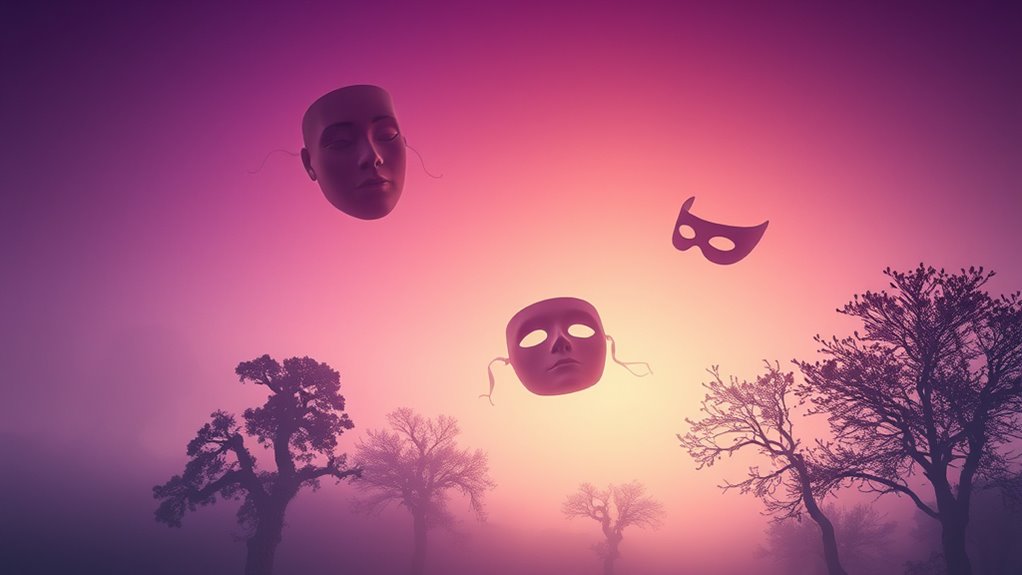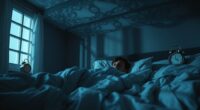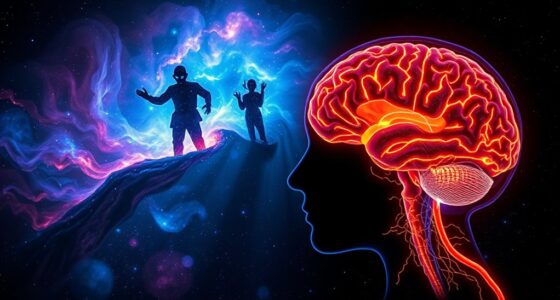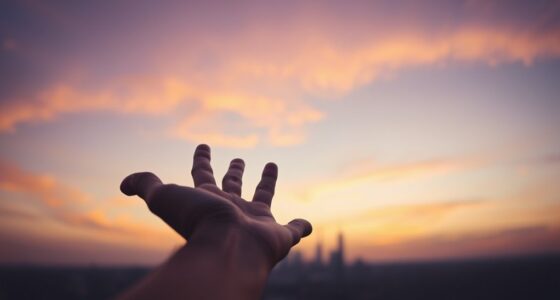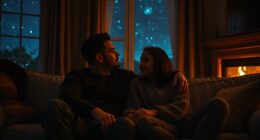Hypnagogic imagery is the fleeting, surreal visuals that appear as you shift from wakefulness to sleep. It acts as a gateway to your subconscious, offering a space where your imagination can roam freely. By minimizing external distractions and practicing sensory deprivation, you can enhance these vivid images and even influence them through lucid dreaming. If you explore this twilight zone further, you’ll uncover how it can open your creativity and inner insights.
Key Takeaways
- Hypnagogic imagery occurs during the transition to sleep, offering surreal visuals that activate the subconscious mind.
- Enhancing these visuals through sensory deprivation and lucid dreaming fosters greater creative insight.
- The vivid, abstract nature of hypnagogic visuals serves as a fertile ground for spontaneous ideas and problem-solving.
- Cultivating awareness of this liminal state allows for intentional exploration of internal imagery and imagination.
- Utilizing hypnagogic imagery as a gateway unlocks creative potential by bridging waking consciousness and subconscious inspiration.
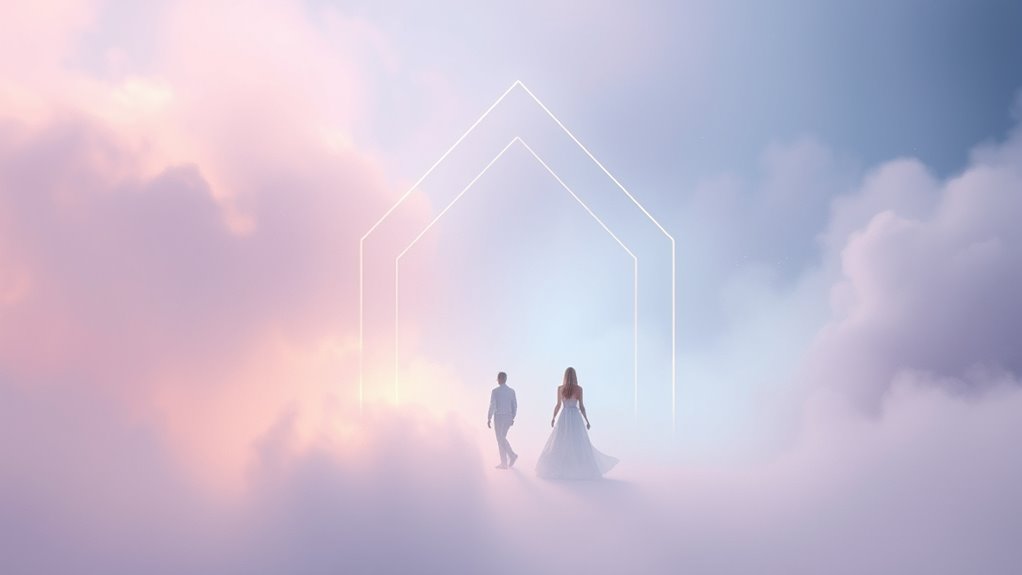
Have you ever experienced fleeting images or scenes as you drift into sleep? That surreal, fleeting moment when your mind begins to wander, and vivid visuals flicker before fading away—this is the domain of hypnagogic imagery. It’s a fascinating gateway to your subconscious, where the boundaries between waking and dreaming blur. During this twilight zone, your brain is highly receptive to ideas and sensations, making it a fertile ground for creativity and insight. One way to deepen this experience is through lucid dreaming, where you become aware that you’re dreaming and can even influence what unfolds. Paired with sensory deprivation—limiting external stimuli—you can enhance the vividness and control of these hypnagogic visions. By intentionally reducing sensory input, perhaps by closing your eyes or creating a quiet, dark environment, you allow your mind to explore these transient images more freely and with greater clarity.
As you settle into the early stages of sleep, your brain starts to produce these fleeting visuals, often bizarre or abstract in nature. You might see swirling colors, shifting patterns, or even entire scenes that seem to play out like a movie. In this state, your mind isn’t bound by logical constraints, so the imagery can be wild and unpredictable. Engaging in lucid dreaming during this phase can turn these fleeting visuals into consciously accessible experiences. When you’re aware that you’re dreaming, you can direct these images, turning them into creative projects or problem-solving sessions. Sensory deprivation plays a key role here, as it minimizes external distractions, helping you focus inward and heighten your awareness of these internal visuals. This combination of techniques makes hypnagogic imagery a powerful tool—not just for entertainment but for accessing creative potential. Additionally, understanding the brain’s activity during sleep can help you better harness these images for inspiration.
Many artists, writers, and thinkers have tapped into this twilight zone to spark inspiration. It’s a space where your subconscious mind freely explores ideas without the constraints of waking logic. By consciously cultivating a state of sensory deprivation and practicing lucid dreaming, you can access these fleeting images more intentionally. This process allows you to harness the raw, unfiltered power of your imagination, often leading to breakthrough insights or innovative concepts. The hypnagogic state is, in essence, a liminal space—an open doorway into your inner world—where the magic of spontaneous creativity happens. With practice, you can learn to linger in this zone, making it a regular part of your creative routine. It’s a fascinating, accessible way to tap into the twilight zone that exists just at the edge of sleep, revealing the endless possibilities hidden within your mind.
Frequently Asked Questions
Can Hypnagogic Imagery Be Intentionally Induced?
Yes, you can intentionally induce hypnagogic imagery through sleep meditation and visualization techniques. By practicing these methods before sleep, you guide your mind into a relaxed state, making it easier to experience vivid, fleeting imagery. Focus on calming your thoughts, then visualize scenes or ideas. Over time, this practice trains your brain to access hypnagogic states deliberately, releasing creativity and insight during your shift into sleep.
How Does Hypnagogic Imagery Differ From Lucid Dreaming?
You might think hypnagogic imagery and lucid dreaming are the same, but they’re quite different. Hypnagogic imagery occurs as you drift into sleep, involving fleeting sensory experiences and spontaneous visuals. Lucid dreaming happens during REM sleep when you’re aware and can control the dream. Using visualization techniques can help you access hypnagogic imagery, but lucid dreaming requires conscious effort and awareness within the dream state.
Are There Risks Associated With Exploring Hypnagogic States?
Exploring hypnagogic states can have some risks, like sleep disruption or nightmares’ impact that might disturb your rest. You could experience vivid, unsettling imagery that affects your sleep quality or triggers anxiety. While generally safe for many, if you notice increased sleep disturbances or emotional distress, it’s wise to take breaks and consult a healthcare professional. Prioritize your well-being to enjoy the creative benefits safely.
Can Hypnagogic Imagery Enhance Problem-Solving Skills?
You can enhance your problem-solving skills by tapping into hypnagogic imagery, which acts as a powerful creative brainstorming tool. This state *releases* innovative catalysts, allowing your mind to make unique connections and generate fresh ideas. As you explore these vivid, fleeting images, you’ll find your ability to think outside the box improves, making complex problems easier to solve. Embrace this twilight zone to boost your creativity and innovation potential.
Is Hypnagogic Imagery Linked to Mental Health Conditions?
You might wonder if hypnagogic imagery is linked to mental health conditions. While it can sometimes resemble hallucinations, it’s usually a normal part of the sleep progression. However, for some, it may connect to mental health issues like anxiety or psychosis. If these images become distressing or persistent, it’s wise to consult a mental health professional. Recognizing the hallucination connection helps differentiate between typical experiences and potential concerns.
Conclusion
As you explore hypnagogic imagery, you tap into a powerful gateway to creativity. This fleeting, dreamlike state sparks ideas you might never access otherwise. Interestingly, studies show that about 70% of inventors and artists have reported inspiration during this twilight zone. So, next time you drift into that liminal space, remember—you’re in a unique zone where imagination thrives. Embrace it, and release your creative potential lurking just beyond conscious thought.

